Thanks again Bugboy. Yes, I too have seen similar spotting in male Common Blues but like you say, only occasionally.
Interesting about the older authors comments, I have a 1947 reprint of South plus a more modern copy of the Howarth version, I'll have to have a look.
Wurzel wrote: ↑Fri Sep 10, 2021 7:28 pm
...Interesting to hear about the fuss on FB about that spotting on the Adonis - I've seen that plenty of times and so after the first couple of times generally don't think of it as anything particularly special...
Cheers Wurzel. Same here, which is why I commented on the FB post and was surprised when some claimed that it was a 'rare form'. Not in my experience it isn't.
Bosham Moths.
I mentioned in one of the previous posts that our room at our B&B in Bosham was on the ground floor and had a small outside area where we could sit outside. I have a portable suitcase type moth trap that I sometimes take along on our trips, although being mains powered I don’t always get the chance to use it in a suitable location. I mentioned it to our hostess who said she was fine with me setting it up in the outside area and in fact was quite interested in it and told us that her brother used to run a moth trap a few years ago.

- Trap in position outside our room - Bosham 31.08.2021
Anyway, with the cloud that had hung around during the day forecast to persist through the night of August 30th, I set the trap up outside our room.
The result the next morning was 39 moths of 16 species, the most interesting of which included a Jersey Tiger Moth, a couple of Canary-shouldered Thorns and 3 White-points.
Jersey Tigers have become quite common in the southern counties over recent years and are now starting to be seen in the more southern parts of the midlands and although I have previously seen a number during the day in Dorset this was the first I have had come to a moth trap.
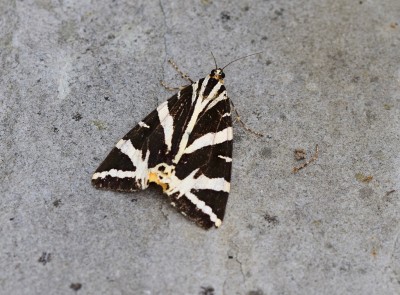
- Jersey Tiger Moth - Bosham 31.08.2021
Canary-shouldered thorns are always good to see and although I do get these back home it is only occasionally and this was the first time I have had more than one at a time.
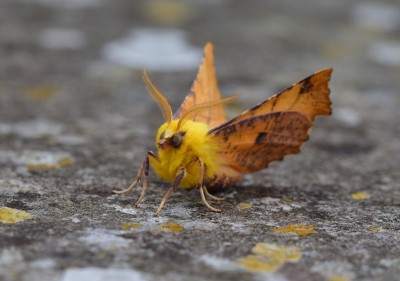
- Canary-shouldered Thorn - Bosham 31.08.2021
The White-point is a regular immigrant that has recently become established in southern counties and East Anglia and which has also started appearing in the midlands over the past couple of years, although I have yet to see it reach my garden.
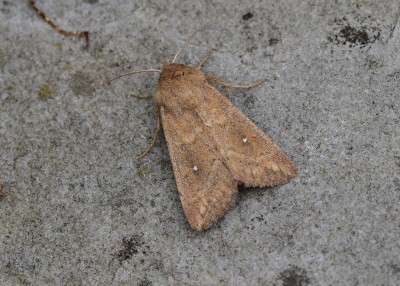
- White-point - Bosham 31.08.2021
I potted some of the moths and showed them to our hosts the following morning before releasing them. They then mentioned that they had a couple of outside power points in their main garden that I was welcome to use if I wanted.
I gave it a rest the following night but the night after that (1st September) I took the opportunity to use one of these power points and set the trap up in the middle of the garden.
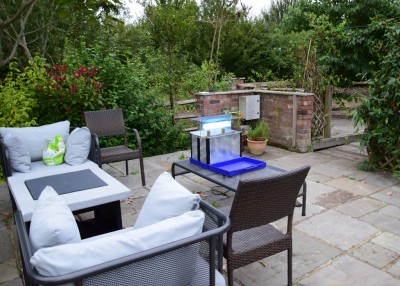
- Trap in main garden - Bosham 01.09.2021
This time the result was 104 moths of 29 species, mostly increased numbers of the same species that I had the previous time but including a Tree-lichen Beauty, another immigrant and recent colonist that is working its way up the country. Some of the moth trappers I know in the southern part of Warwickshire have been seeing these but again, I have yet to see one in my garden.
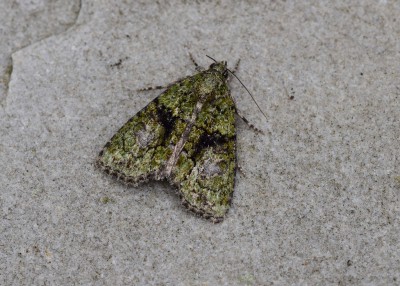
- Tree-lichen Beauty - Bosham 01.09.2021
A single Centre-barred Sallow was my first of the year and is one of the species whose arrival signifies that we are heading into autumn.
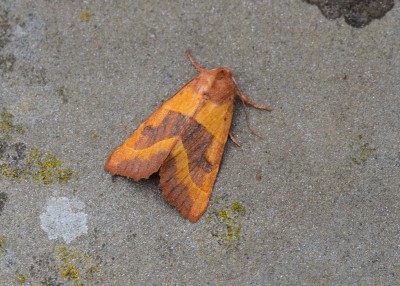
- Centre-barred Sallow - Bosham 01.09.2021
Other moths of interest included another 8 White-points and a couple of moths which I think have great common names, Maidens Blush and Setaceous Hebrew Character (15).
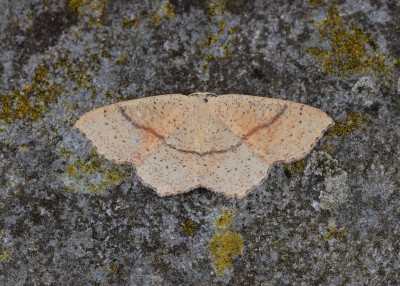
- Maiden's Blush - Bosham 01.09.2021
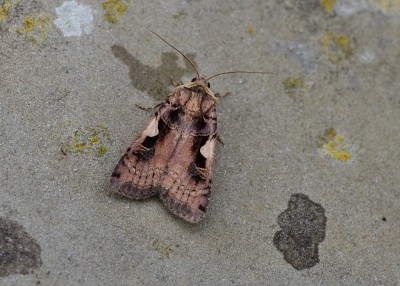
- Setaceous Hebrew Character - Bosham 01.09.2021
The rest were a selection of the usual common and widespread species that turn up everywhere such as Large Yellow Underwing (23)
That completes the reports from our few days down south. The weather was not the best with a lot of thick cloud most of the time but having said that we did have a few nice sunny spells and the temperature was usually in the mid to high teens and felt reasonably warm.
I saw lots of butterflies which included plenty of my three main targets, these being Adonis and Chalk Hill Blues and Silver-spotted Skippers.
It would have been nice to see a Clouded Yellow but it was not to be this time. Besides, with Sarah now living down there, I am sure I will get plenty of opportunities when we visit in the future.
Bye for now and stay safe,
Neil
 Interesting to hear about the fuss on FB about that spotting on the Adonis - I've seen that plenty of times and so after the first couple of times generally don't think of it as anything particularly special
Interesting to hear about the fuss on FB about that spotting on the Adonis - I've seen that plenty of times and so after the first couple of times generally don't think of it as anything particularly special  I find some of the aberration names useful when describing the variation that I'm seeing (saying ab.postexcessa is a bit easier than got extra spots along the hind wing margin) but I think the 'Collectors' liked to name every slight variation as it meant that they'd get some recognition or renown a bit like a watered down version of discovering and getting to name a species
I find some of the aberration names useful when describing the variation that I'm seeing (saying ab.postexcessa is a bit easier than got extra spots along the hind wing margin) but I think the 'Collectors' liked to name every slight variation as it meant that they'd get some recognition or renown a bit like a watered down version of discovering and getting to name a species  However this doesn't hold true for Hedge Browns obviously
However this doesn't hold true for Hedge Browns obviously 
